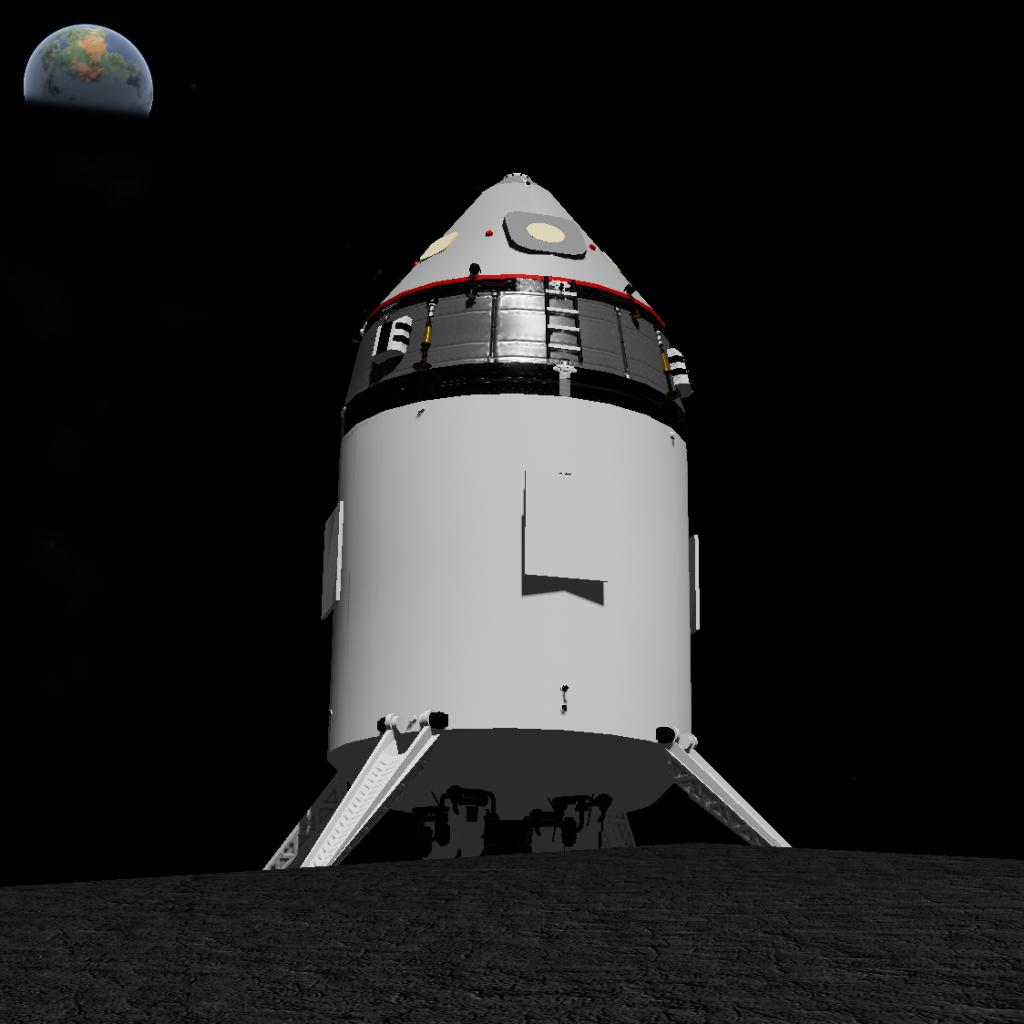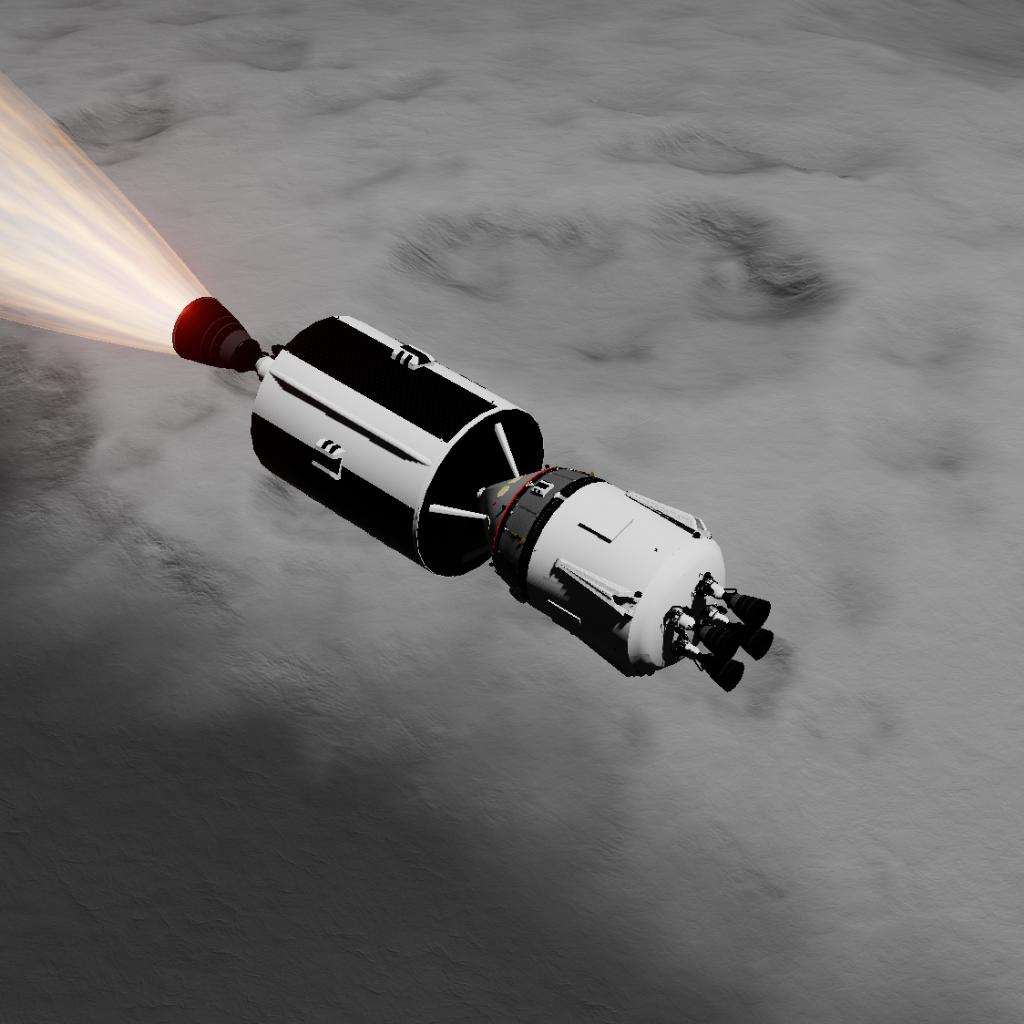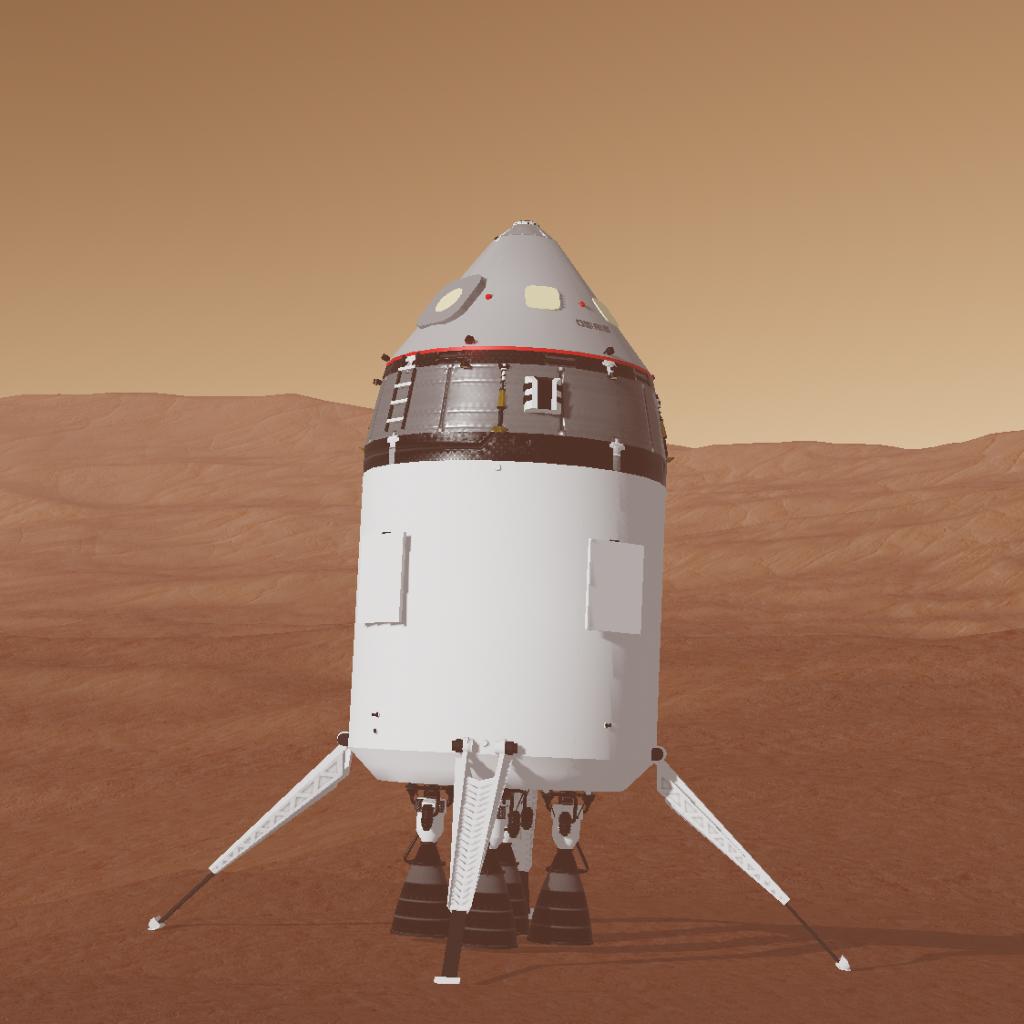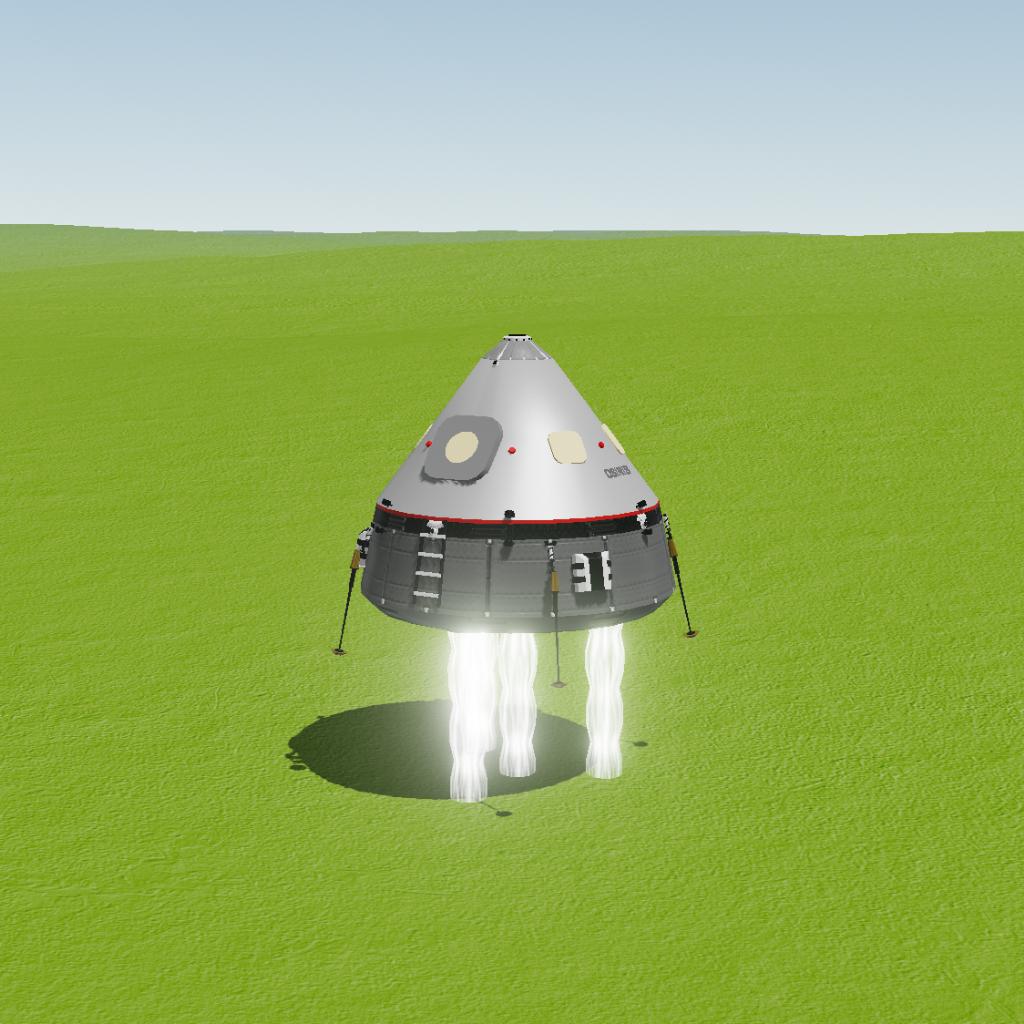About the rocket:
”Weka IV.III-B.6-2”
Overview:
The Weka IV.III-B.6-2 (Weka IV-B for short) is named after the Weka, a bird that can’t fly because it’s too fat. Unlike the bird however, I made sure that this incredibly over-engineered “boom tube” would fly, standing 185 meters (607 feet) tall and weighing in at 21,300,000 kilograms (47,000,000 pounds) when fully fueled. This rocket produces 233,700,000 newtons (23,800,000 kilograms or 52,500,000 pounds) of thrust at liftoff, which gives it a launch TWR of 1.08 - just barely getting it off the ground. This rocket has taken me the longest build out of any other rocket. It’s been in development since late October, so I’m happy to finally get it out.
The main rocket only has two stages, it was designed to bring large amounts of payload (like the Osiris craft) into orbit, rather than go long distances. It can deliver about 3,100 metric tons to LDO (100km), 1,500 metric tons to a low orbit around Luna (30km), and finally 500 metric tons to a low orbit around Cylero (65km).
Features:
- Two main stages
- Six solid strap-on boosters
- The Osiris craft
- A detailed exterior
- A working launch escape system
- Solid rocket motors for better and safer stage separation
- Cameras all over the place to get a view from every angle, including a docking cam
- Lights that illuminate the whole rocket, including docking and landing lights (kind of laggy though)
- Labeled activation groups
- Named engines and interstages, as well as some of the main fuel tanks to minimize confusion if/when restaging
- More than enough Monoprope to rendezvous and dock
- Custom landing gear on the Osiris CM
- Airbrake on the Osiris SM
- Battery and solar panels
- Multiple heat shields to prevent damage on re-entry
Launch:
Below is what I have found to be the best way to get into orbit with this rocket. If you already know how to get into orbit, then you can skip this part.
Lock heading to east and pitch to 90 degrees prior to ignition. Once liftoff has been confirmed continue to fly east @ 90 degrees until altitude AGL is 1,500. At AGL 1,500 set pitch to east @ 75 degrees. At AGL 5,000 set pitch to east @ 60 degrees. At AGL 10,000 set pitch to east @ 45 degrees. At AGL 15,000 set pitch to east @ 30 degrees. Note: AGL 14,500-15,500 is when the strap-on boosters burn out, so make sure to adjust pitch just before AGL 15,000 to jettison the boosters on time. At AGL 30,000 set heading to east @ 15 degrees and continue burning at this heading until stage 1 burnout. After stage 1 jettison set pitch to east @ 0 degrees to level out and ignite stage 2. Continue burning at this heading until apoapsis is 100km. Execute circularization burn at apoapsis.
Disclaimer: Absolutely no mass editing was used in the creation of the Weka, however XML editing and tinker panel were used to increase text size and simplify staging activation.
About the payload:
”Osiris.VI CSM & MS”
Overview:
The Osiris.VI CSM & MS is a two part craft, that functions similar to NASA’s Apollo spacecraft, however it is more universal, allowing for multiple types of missions instead of just lunar landings. Together the CSM and MS weigh about 1,300,000 kilograms (2,900,000 pounds).
I got the idea when building my Cylero rocket series, and discovered how much fine tuning and planning it takes just to build a rocket without having too much or too little fuel for one specific mission. I designed a craft that had the lander on top, so that it could separate without throwing the fuel away from any remaining stages. The CSM doubles as a lander. The MS is a modified stage that allows the CSM to dock to the rest of the rocket with no wobble.
Osiris Command and Service Module:
The Osiris Command and Service Module (CSM) is two stages, the first stage is the Service Module (SM), and the second stage is the Command Module (CM). Both stages have landing capabilities for maximum versatility.
The SM is equipped with four main engines, air brakes, and landing gear. It has high enough TWR to take off from Droo, but still low enough to land on Luna and Cylero.
The CM is a fully functioning craft on its own, with its own fuel, engines, RCS, batteries and solar panels, as well as custom designed landing gear and its own heat shield. The CM also has a high enough TWR to take off from Droo and and low enough TWR to land on Luna and Cylero, but it is lower than the SM, so use caution when landing on Droo with it.
The Capsule is all that remains after the CM is jettisoned, it is the part where the astronauts stay. It has a docking port, lights, a drogue chute, three main chutes, and a heat shield. This is where battery and Monoprope is stored for the CSM.
Osiris Mother Ship:
The Osiris Mother Ship (MS) is a modified stage that has its own RCS, battery, and solar panels. It has its own docking port, so that it can dock with the CSM and movable struts that keep the CSM stable when docked. It uses Kerolox, which is generally a bad idea for upper stages and also the reason the payload is so heavy, but I wanted the Osiris to have the most delta V possible on its own, so I just decided to make the rest of the rocket bigger to accommodate the weight of this stage.
Instructions:
If you actually plan on doing missions with this rocket (instead of getting it so you can just blow it up for fun) then please read these instructions, because this craft is not as straightforward as my other ones. Most of you can probably figure out the majority of the basics on your own, but for clarity and the things that aren’t so obvious, here it is:
It is very similar to the Apollo style missions, where one part goes down to land, and the other stays in orbit. For this craft, the CSM is what goes down to land and the MS is what stays in orbit. Once orbiting the body you plan to land on, use the AG for SM Separation to disconnect both sides of the interstage, do not use the staging, because the staging only disconnects one side of the interstage. If done properly, the interstage most likely won’t explode, but if it does then it’s probably not a big deal. The CSM lands while the MS stays in its current orbit. The landing gear do not have their own stage, they need to be activated via AGs. Once ready to go back up, it launches off the surface and rendezvous with the MS. The docking camera and lights help tremendously with docking, because sometimes it’s dark when they are preparing to dock. Once docked, immediately unlock heading and disable all AGs so that it doesn’t interfere with the MS as it flies. Switch to the MS by tapping or clicking on any part on the MS and selecting that part’s command chip from the menu to take control. Now that you are controlling the MS instead of the CSM use Slider 1 to engage the stability struts and activate the AG for MS Power. Once you are ready to disconnect for another landing or Droo re-entry, use Slider 1 to disengage the stability struts, and follow the previous steps to switch back to the CSM and undock.
Disclaimer: Absolutely no mass editing was used in the creation of the Osiris, however tinker panel was used to simplify staging activation and modify collision response for the heat shield.
Activation Groups and Sliders:
Activation Groups:
- AG1: Abort
- AG2: Lights
- AG3: Capsule Power
- AG4: Mother Ship Power
- AG5: SM Separation
- AG6: CM Engines
- AG7: SM Engines
- AG8: Landing Gear
- AG9: Solar Panels
- AG10: RCS
All AGs also labeled in-game
Sliders:
Osiris CSM:
- Slider 1: CM landing gear
- Slider 2: SM air brake
Osiris MS:
- Slider 1: Stability struts
You can find my other rockets here
GENERAL INFO
- Predecessor: Weka III.II-B (Osiris)
- Successors 1 craft(s) +21 bonus
- Created On: iOS
- Game Version: 0.9.509.0
- Price: $910,751k
- Number of Parts: 432
- Dimensions: 185 m x 26 m x 31 m
PERFORMANCE
- Total Delta V: 16.9km/s
- Total Thrust: 301.4MN
- Engines: 49
- Wet Mass: 2.13E+7kg
- Dry Mass: 1.05E+6kg
STAGES
| Stage | Engines | Delta V | Thrust | Burn | Mass |
|---|---|---|---|---|---|
| 1 | 15 | 3.9km/s | 233.7MN | 3.6m | 2.13E+7kg |
| 2 | 0 | 0m/s | 0N | 0s | 1.71E+7kg |
| 3 | 0 | 0m/s | 0N | 0s | 4.28E+6kg |
| 4 | 4 | 3.3km/s | 36.9MN | 4.0m | 4.28E+6kg |
| 5 | 0 | 0m/s | 0N | 0s | 4.27E+6kg |
| 7 | 0 | 0m/s | 0N | 0s | 1.28E+6kg |
| 8 | 1 | 4.8km/s | 11.9MN | 4.3m | 1.28E+6kg |
| 10 | 4 | 3.2km/s | 3.1MN | 2.2m | 1.79E+5kg |
| 12 | 4 | 1.7km/s | 755kN | 1.9m | 62,457kg |
18 Comments
- Log in to leave a comment
-
-
-
1,962 Caleb0014.6 years ago
@EffIcentRocketEngineering I looked on your profile and I couldn't find it. Is it by any chance unlisted?
-
-
-
-
11.5k Chtite451SR2+1 5.0 years ago
If you actually plan on doing missions with this rocket (instead of getting it so you can just blow it up for fun)
uh...
i swear some people are just idk...
this is good XD
-
60 Gellie5.0 years ago
@Caleb001 yeah and thanks for that!!!😂
I actually first thought it wasn't there on the staging and then I pressed the docking port and I saw that you can jettison it and then saw the parachutes sticking out😂 -
-
60 Gellie5.0 years ago
I ran out of fuel while I was about to re enter so I had to use plan B, PARACHUTE!!
-
-
-
-
-
-
-










I have noticed a problem where for some reason the pictures disappear from the description every couple of hours, so if there are any awkward empty spaces, that’s what they are. I try to fix it every time I see it, but it’s kind of time-consuming.